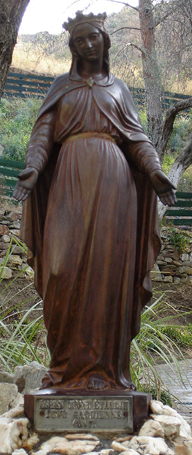 July 29
July 29
Meryem Ana, Ephesus, Selšuk, İzmir, Turkey
In the Bible, Mary is last seen at the Cross, where the dying Jesus gives her as mother to "the disciple whom he loved" (John 19:26). Christians soon came to identify this disciple with St. John, author of the Gospel, said to have spent his last years in Ephesus. Although early traditions, through the middle ages, placed the Virgin Mother's final days in Jerusalem, the idea that she accompanied the Beloved Disciple to Ephesus had gained currency by 1670, when Venerable Maria d'Agreda wrote of it in The Mystical City of God. In the 1820s, stigmatic Blessed Anne Catherine Emmerich, from her sickbed in Germany, saw detailed visions of the lives of Christ and his mother, which poet Clemens Brentano recorded. The Life of the Blessed Virgin Mary was published in 1852, after both Emmerich and Brentano were dead. Blessed Catherine envisioned Mary's stone house, built by St. John over a stream, to be part of a small Christian community on a "wild, overgrown height ... nearer to the sea than Ephesus." In 1891, Sister Marie de Mandat-Grancey, at the Daughters of Charity mission in Smyrna (Izmir), convinced two French Lazarist missionaries, Henri Jung and Eugene Poulin, to climb Mt. Koressos near Ephesus to check reports of an old structure corresponding to the mystic's vision. On July 29, they found a ruined chapel which fit Blessed Catherine's description uncannily. It turned out that local tradition held it to have been the house of Mother Mary (Meryem Ana), near the sacred spot from which she was assumed into heaven. In a year's time, foreign Catholics were joining the local pilgrimage to Mt. Koressos for the Feast of the Assumption on August 15. Lazarist Fathers came to renovate the building and manage the site, which they still do. The August gathering attracts Moslems, who regard Mary as a saint, as well as Christians. The Catholic Church has never ruled if this was really Mary's house or the site of her Assumption, but Popes Paul IV, John Paul II, and Benedict XVI all visited here. It is unclear what happened to the damaged statue of Mary found in the chapel in 1891. The statue now on the altar is similar to the one on the grounds (right), but missing its hands since World War II. The plaque below the statue in the photograph reads, "Elles m'ont etablie leur gardienne - 1867 ("They've established me as their guardian"). This is probably a reference to the Daughters of Charity, who took Mary as their guardian.
Sources include:
| "House of the Virgin," Ephesus, Turkey, www.sacred-destinations.com/turkey/ephesus-house-of-the-virgin.htm | |
| Photo by Chris Trost of statue on grounds from ctrost.blogspot.com. |
Also celebrated this date:
| Notre-Dame des Fontaines, Pontrieux, C˘tes-d'Armor, Brittany, France. First stone laid, 1840; pardon third Sunday. | |
| Notre-Dame, Larmor-Baden, Morbihan, Brittany, France. Parish church of Notre-Dame blessed, 1880. | |
| Madonna dello Zerbion, Saint-Vincent, Aosta, Italy | |
| Nostra Signora del Mirteto, Ortonovo, La Spezia, Liguria, Italy (Our Lady of the Myrtle). Image wept blood, 1537. | |
| Chirsk Mother of God, Pskov, Pskov, Russia. July 16 in the old calendar. | |
| Madonna dei Miracoli, Morbio Inferiore, Ticino, Switzerland. The Madonna appeared and cured two possessed girls, 1594. |